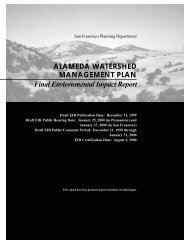Feasibility of Fish Passage at Alameda Creek Diversion Dam
Feasibility of Fish Passage at Alameda Creek Diversion Dam
Feasibility of Fish Passage at Alameda Creek Diversion Dam
You also want an ePaper? Increase the reach of your titles
YUMPU automatically turns print PDFs into web optimized ePapers that Google loves.
<strong>Feasibility</strong> <strong>of</strong> <strong>Fish</strong> <strong>Passage</strong> <strong>at</strong> <strong>Alameda</strong> <strong>Creek</strong> <strong>Diversion</strong> <strong>Dam</strong>Trap and haul was also evalu<strong>at</strong>ed, and was determined to be potentially suitable for steelhead passage<strong>at</strong> ACDD due to its ability to move immigr<strong>at</strong>ing fish past ACDD, and past Little Yosemite. LittleYosemite is a high-gradient reach <strong>of</strong> <strong>Alameda</strong> <strong>Creek</strong> with exposed bedrock and large bouldersapproxim<strong>at</strong>ely 2 miles downstream <strong>of</strong> ACDD th<strong>at</strong> may limit the ability <strong>of</strong> future steelhead to accessthe reach immedi<strong>at</strong>ely below the diversion dam. Trap and haul <strong>at</strong> ACDD would involve trappingimmigr<strong>at</strong>ing adult steelhead below the dam (or below Little Yosemite) and hauling them to a releasesite above ACDD. Trap and haul would not require collection or reloc<strong>at</strong>ion <strong>of</strong> emigr<strong>at</strong>ing steelheadbecause fish screen bypass flows would provide safe downstream passage <strong>at</strong> ACDD and LittleYosemite is not expected to significantly affect potential steelhead emigr<strong>at</strong>ion. Due to the uncertainty<strong>of</strong> passage conditions <strong>at</strong> Little Yosemite, trap and haul is retained in the analysis as a technologicallyfeasible option for providing passage.<strong>Fish</strong> ladders were determined to be suitable for use <strong>at</strong> ACDD, contingent upon steelhead being able toimmigr<strong>at</strong>e through Little Yosemite. The advantage <strong>of</strong> fish ladders over fish lifts and trap and haul isth<strong>at</strong> they provide volitional passage with minimal handling and associ<strong>at</strong>ed stress to the fish, comparedto other fish passage methods. Two potential ladder configur<strong>at</strong>ions were evalu<strong>at</strong>ed for use <strong>at</strong> ACDD,a short fishway th<strong>at</strong> would provide an exit for fish immedi<strong>at</strong>ely above ACDD, and a long fishway th<strong>at</strong>would provide an exit for fish approxim<strong>at</strong>ely 400 feet farther upstream, above the hydrologicinfluence <strong>of</strong> the dam. Both fishways would involve construction around ACDD on the right bank <strong>of</strong><strong>Alameda</strong> <strong>Creek</strong>; the near-vertical rock wall and presence <strong>of</strong> existing facilities limit the feasibility <strong>of</strong>constructing a fish ladder on the left bank <strong>of</strong> the channel. Although both configur<strong>at</strong>ions arepotentially feasible, a long fishway th<strong>at</strong> joins <strong>Alameda</strong> <strong>Creek</strong> upstream <strong>of</strong> the hydraulic influence <strong>of</strong>ACDD may <strong>of</strong>fer gre<strong>at</strong>er control over the flows th<strong>at</strong> pass down the fishway than a short fishway th<strong>at</strong>joins <strong>Alameda</strong> <strong>Creek</strong> immedi<strong>at</strong>ely upstream <strong>of</strong> the dam. Therefore, the long fishway concept iscarried forward for further analysis in the technical memorandum.Design components th<strong>at</strong> were determined to be suitable for providing fish passage <strong>at</strong> the ACDD basedon the first tier <strong>of</strong> analysis were then evalu<strong>at</strong>ed based on estim<strong>at</strong>ed capital, oper<strong>at</strong>ions, andmaintenance costs. The estim<strong>at</strong>ed total capital cost <strong>of</strong> design components associ<strong>at</strong>ed with a fishladder passage option and a trap and haul passage option are <strong>of</strong> a similar order <strong>of</strong> magnitude($23.7 and $21.7 million, respectively), more than half <strong>of</strong> which is the estim<strong>at</strong>ed cost <strong>of</strong> fish screens<strong>at</strong> the ACDT. Including the estim<strong>at</strong>ed w<strong>at</strong>er costs, the order-<strong>of</strong>-magnitude capital and oper<strong>at</strong>ing andmaintenance cost for fish passage with screening <strong>at</strong> ACDD, annualized over a period <strong>of</strong> 30 years, isestim<strong>at</strong>ed <strong>at</strong> approxim<strong>at</strong>ely $4 million annually for either a fish ladder or trap and haul passageoption. In both cases, more than $3 million <strong>of</strong> the estim<strong>at</strong>ed annual cost is associ<strong>at</strong>ed with screens. Asignificant portion <strong>of</strong> the annual cost <strong>of</strong> passage <strong>at</strong> the ACDD is estim<strong>at</strong>ed to be lost w<strong>at</strong>er diversionopportunity cost.This memorandum also presents preliminary analysis <strong>of</strong> the potential biological benefit <strong>of</strong> providingpassage for steelhead <strong>at</strong> ACDD. Portions <strong>of</strong> <strong>Alameda</strong> <strong>Creek</strong> above ACDD do not have perennialflow; therefore, above ACDD fish habit<strong>at</strong> is limited during the dry season. A comprehensive survey<strong>of</strong> available habit<strong>at</strong> above ACDD has not been conducted, and it is unknown whether spawning andjuvenile rearing habit<strong>at</strong> above ACDD is sufficient to support a self-sustaining popul<strong>at</strong>ion. If thequantity and quality <strong>of</strong> habit<strong>at</strong> are not sufficient to support a self-sustaining popul<strong>at</strong>ion above ACDD,provision <strong>of</strong> passage could still contribute to a steelhead metapopul<strong>at</strong>ion in the <strong>Alameda</strong> <strong>Creek</strong>W<strong>at</strong>ershed, if additional subpopul<strong>at</strong>ions are established in other reaches.CONCLUSIONSAn effort to establish steelhead access above the ACDD would have a reasonable probability <strong>of</strong>success based on this preliminary analysis. While a fish ladder is a technologically feasible option forACDD <strong>Passage</strong> June 2009Page ES-2








